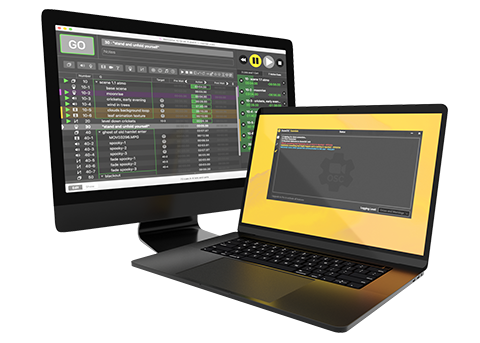

Often in theatrical situations, you may want to use Isadora to trigger QLab cues in order to reduce the number of operators required for a given production.
#QLAB OSC API SOFTWARE#
Like Isadora, QLab is a powerful cueing software tool. More information about QLab's OSC capabilities.Our Knowledgebase article on the subject of controlling Isadora with QLab using OSC.If no arguments are provided for /dim, return whether or not DIM is currently engaged.Solution home Tutorials Tutorials - Scripting, Sensors and Interfacing Controlling QLab Using Isadora Via OSC If time is omitted, the Show Settings > Master Volume Dim Duration is used. If provided, the master volume will be faded from its current value over that many seconds. Time is an optional whole or decimal number. Number is interpreted as a boolean 0 equals false, any other number equals true. Releasing fades the master volume back up to its undimmed level. When engaged, the master volume is faded down by the value set in Show Settings > Master Volume Dim (dB). Equivalent to the remote control actions “Step Up Master Volume” and “Step Down Master Volume”.Įngages or releases the “DIM” setting in the master volume fader. The valid range for percent is 0.0 to 1.0.įades the master volume level of a show up or down by 6 dB. The master volume of a show represented on a linear scale as a percentage. The valid range for decibels is -96.0 to 0.0. The master volume of a show represented in decibels. If no argument is provided for /masterVolumeVisible, return the current visibility of the master volume fader. Reveals or hides the visibility of the master volume fader. Reply FormatĪll replies from Go Button take the form: You can send OSC messages to Go Button using any of these IP addresses. When that or any other connection is active, the IP addresses of those networks are also listed. Newer versions of macOS can also set up a local TCP connection with an iOS device over a USB-to-Lightning cable. On iOS devices, the primary network interface is typically the Wi-Fi connection, which is reported to the system as “en1”.

To view reply messages in the QLab Workspace Status > Logs window, set the Go Button UDP Reply Port to 53000.įor convenience, the Sidebar > OSC Control Settings > Network also lists the IP address(es) for your current device. You can change the settings to use the new default ports 5311 if desired. When updating to Go Button 3.2.x, those previous default port numbers (5301) are migrated to OSC Control Settings to avoid a breaking change with any controllers that still expect those values.


 0 kommentar(er)
0 kommentar(er)
